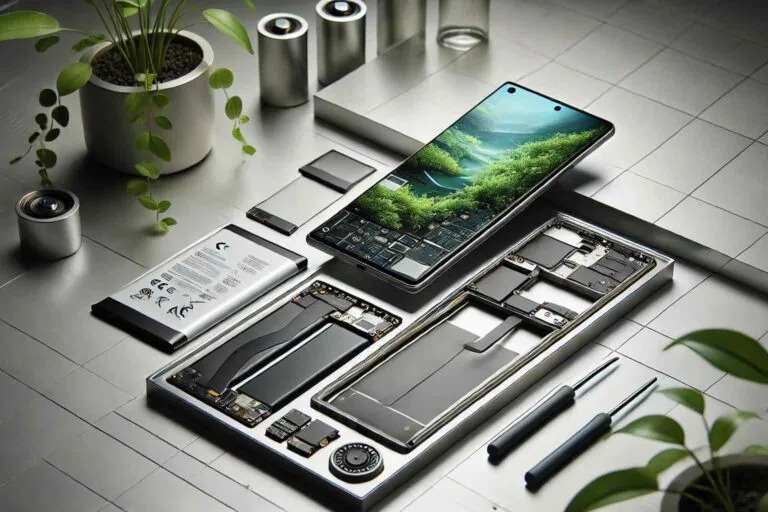
Modular phones/devices: repairability, upgradeability, sustainability.
Modular phones and devices are reshaping the future of personal electronics by offering repairable, upgradeable, and sustainable alternatives to disposable smartphones. By allowing users to replace or enhance individual components, these devices extend lifespan, reduce e-waste, and promote environmental responsibility, empowering consumers while challenging conventional technology cycles dominated by planned obsolescence and constant replacement.
✨ Raghav Jain

Introduction: The Disposable Tech Dilemma
The modern smartphone industry thrives on constant innovation, but this innovation has a dark side—planned obsolescence. Consumers are encouraged to replace devices every one or two years, leading to massive electronic waste and resource depletion. According to the Global E-waste Monitor 2024, over 62 million tonnes of e-waste were generated globally, much of it from discarded gadgets. While sleek designs and cutting-edge features drive sales, they also make repair and component replacement nearly impossible.
Enter modular phones—a revolutionary concept that could solve the sustainability puzzle. By allowing users to replace or upgrade individual components—like cameras, batteries, or processors—without discarding the entire device, modular technology reimagines how we build and maintain electronic devices.
The Concept of Modular Design
At its core, modularity is the idea of building a device from interchangeable parts, each serving a specific function. Rather than soldering components permanently onto a motherboard, they are designed as detachable modules. Users can swap out parts easily, much like changing Lego bricks.
This approach offers three key benefits:
- Repairability – A cracked screen, a weak battery, or a faulty speaker no longer means replacing the whole device. You can just replace the damaged module.
- Upgradeability – When technology advances, instead of buying a new phone, you can simply upgrade specific parts such as the camera module or RAM.
- Sustainability – By reducing electronic waste and extending product lifespan, modular devices contribute directly to a circular economy, minimizing the need for raw material extraction.
A Brief History: The Rise and Fall (and Rise Again)
The modular phone idea first captured global attention in 2013 with Google’s ambitious Project Ara. It promised a fully customizable phone where every component—from the camera to the CPU—could be replaced independently. Despite huge excitement, Ara struggled with technical and cost challenges and was eventually discontinued in 2016.
However, the concept didn’t die there. Companies like Fairphone, Shiftphone, and Framework revived modularity with a more practical approach. Instead of full modularity, they focused on partial modularity—offering easily replaceable batteries, screens, and key components. Fairphone, in particular, became a poster child for sustainable electronics.
Fairphone’s models (Fairphone 2, 3, 4, and the recent Fairphone 5) allow users to repair or replace 10+ components themselves. Similarly, Framework, a laptop brand, extended this philosophy to computers, letting users swap parts and even upgrade processors without discarding the device.
These companies proved that modularity isn’t just a futuristic dream—it’s an achievable path toward sustainable technology.
The Engineering Behind Modularity
To understand why modular design is both revolutionary and challenging, it’s crucial to grasp its engineering implications.
Traditional smartphones are designed for compactness and performance efficiency. Components are tightly packed, often glued or soldered together, minimizing space and maximizing waterproofing and strength. Modular phones, by contrast, must balance flexibility with reliability.
Key engineering challenges include:
- Interconnection: Ensuring seamless communication between detachable modules without lag or power loss.
- Structural Integrity: Making sure the phone remains durable even with removable parts.
- Design Aesthetics: Maintaining sleekness and comfort while incorporating replaceable modules.
- Software Integration: The operating system must recognize and adapt to new modules on the fly.
Despite these hurdles, advancements in magnetic connectors, standardized ports, and software modularity (like Android’s Project Treble) are bridging the gap between idealism and practicality.
Repairability: Empowering Users and Technicians
One of the most immediate benefits of modular devices is repairability. In traditional smartphones, replacing a battery or screen can be expensive and risky. Many companies intentionally make self-repair difficult, forcing users toward official service centers or replacements.
Modular phones turn this on its head. With a screwdriver and a basic guide, users can replace a broken screen, upgrade their camera, or swap a dying battery in minutes. Fairphone even provides step-by-step tutorials and sells spare parts directly.
This level of accessibility empowers consumers, reduces repair costs, and extends device life by several years. In the long run, it shifts the market’s dependency away from proprietary repair monopolies and aligns with the “Right to Repair” movement, now gaining global legal support.
Upgradeability: Future-Proofing Devices
Technology evolves rapidly. Within two years, camera resolutions double, processors shrink, and new wireless standards emerge. Traditionally, this meant buying a new phone to stay current. But modularity changes that.
Imagine replacing just your camera module for a newer one or swapping your storage module from 128GB to 512GB. This future-proofing capability ensures that users can keep pace with technology without generating unnecessary waste.
Framework laptops are leading the way here—users can upgrade even the CPU by replacing the mainboard, turning what was once “obsolete” into “renewed.” If the smartphone industry fully adopts this model, users could realistically keep their devices for five to seven years or more—unheard of in the current market.
Sustainability: A Green Revolution in Tech
The sustainability implications of modular devices are profound. Each smartphone contains precious and rare materials—gold, cobalt, lithium, and rare earth metals—whose extraction causes significant environmental and social harm.
When users discard devices frequently, this demand multiplies, fueling unethical mining and pollution. Modular devices, by extending product lifespan and reducing replacements, dramatically cut down this demand.
Moreover, companies like Fairphone use recycled materials, ensure fair labor practices, and minimize carbon footprints throughout their supply chains. A study by the Fraunhofer Institute estimated that extending smartphone lifespan from 2 years to 5 years could reduce carbon emissions by up to 50% per device.
This is not just good for the planet—it’s good business. Sustainable brands increasingly attract eco-conscious consumers who value longevity over luxury.
The Business and Economic Perspective
While modularity makes environmental sense, its business model challenges traditional profit structures. Big tech companies rely on short product cycles and constant upgrades to maintain revenue streams. A phone that lasts 5–7 years and can be easily repaired disrupts this pattern.
However, modularity opens new economic opportunities:
- Component Marketplaces – Users can buy, sell, or trade individual modules.
- Subscription Models – Pay monthly for upgrades or maintenance instead of full replacements.
- Service-Based Ecosystems – Brands could earn from support, software updates, and module innovation rather than entire device sales.
This shift represents a move toward service-oriented technology, where sustainability and profitability coexist.
Challenges to Widespread Adoption
Despite its potential, modularity isn’t without hurdles:
- Design Limitations – Fully modular phones tend to be bulkier and less water-resistant.
- Cost – Modular production requires precise engineering, which can raise manufacturing costs.
- Consumer Mindset – Many consumers still prefer sleek, all-in-one devices over practical repairability.
- Industry Resistance – Major smartphone brands have little incentive to disrupt their profitable upgrade cycles.
However, with growing awareness about sustainability and e-waste legislation, these barriers are slowly weakening. The EU’s 2024 Right to Repair Directive and similar policies in the U.S. and India are pushing companies to prioritize repairability.
The Future of Modular Devices
The future of modularity may not lie in full customization but hybrid modularity—a balance between flexibility and compactness. Upcoming concepts like magnetically attached add-ons, software-level modular upgrades, and AI-assisted hardware optimization could redefine the modular experience.
For instance, Motorola’s Moto Mods allowed users to snap additional modules—such as speakers, projectors, or extra batteries—onto their phones magnetically. Though not fully modular, such semi-modular designs bridge the gap between convenience and sustainability.
In the coming years, as 3D printing, biodegradable materials, and AI-based predictive maintenance mature, modularity could become the foundation of all personal electronics—from phones and laptops to wearables and IoT devices.
In an age where technology evolves faster than ever, our dependence on sleek yet short-lived gadgets has given rise to an unsustainable cycle of consumption and waste. The smartphone, once a marvel of compact engineering, has ironically become one of the leading contributors to global electronic waste, with over 62 million tonnes generated annually according to the Global E-waste Monitor 2024. The culprit lies not only in our craving for the latest technology but also in how modern devices are designed—sealed shut, nearly impossible to repair, and intentionally difficult to upgrade. Enter the concept of modular phones, a revolutionary idea that seeks to dismantle this “throwaway culture” by introducing flexibility, repairability, and longevity into our devices. A modular phone is constructed from detachable, interchangeable components—each performing a specific function such as processing, storage, imaging, or power supply—allowing users to replace or upgrade individual modules instead of discarding the entire device. The foundation of modular design rests on three interconnected pillars: repairability, which empowers users to fix or replace defective parts easily; upgradeability, which enables them to adapt their device to new technologies without complete replacement; and sustainability, which reduces the ecological footprint of manufacturing and disposal. The story of modular devices began over a decade ago with Google’s ambitious Project Ara in 2013—a vision to build a phone as customizable as Lego bricks. Users could swap a high-resolution camera for a thermal sensor, change batteries on the go, or upgrade the processor whenever a new version launched. Though technically and commercially challenging, Ara sparked a global conversation about the right to repair and the future of sustainable electronics. While Google’s project was eventually discontinued in 2016, its spirit lived on through pioneers like Fairphone in the Netherlands, Shiftphone in Germany, and Framework in the laptop market. These companies embraced a pragmatic approach—offering partial modularity focused on key replaceable parts such as screens, batteries, and cameras—balancing convenience with durability. Fairphone, often cited as the world’s most ethical smartphone, allows users to replace nearly every critical component with a simple screwdriver, accompanied by official repair guides and direct-to-consumer spare parts. The result is a device that can last twice as long as traditional phones, lowering both the cost to consumers and the strain on natural resources. The engineering behind modularity, however, is no small feat. Modern smartphones are feats of ultra-dense integration—thin, waterproof, and compact, with components soldered and glued into place to achieve maximum efficiency. Making them modular requires ingenious design solutions to maintain electrical integrity, performance, and physical resilience while still enabling disassembly. This means inventing robust connector systems, standardizing module interfaces, and ensuring the operating system dynamically recognizes new hardware configurations. Though modular devices tend to be slightly bulkier, advancements in miniaturization, magnetic coupling, and software modularity (like Android’s Project Treble) are helping bridge the gap between flexibility and performance. From a consumer standpoint, the immediate advantage of modularity lies in repairability—the power to fix your own device without depending on proprietary tools or expensive service centers. For decades, manufacturers have made self-repair difficult, citing security and design reasons but often motivated by economic control. Modular phones flip this paradigm: if your camera malfunctions, you replace only that module; if your battery loses capacity, you swap it out in seconds. This not only extends the device’s lifespan but also aligns perfectly with the global Right to Repair movement, now supported by growing legislation across the EU, the US, and India. The long-term economic impact is equally important. Consumers save money over time, and small-scale repair industries flourish again as technology becomes accessible instead of locked behind corporate barriers. The second major promise—upgradeability—is equally transformative. In a world where camera technology, processing power, and storage capacity evolve every year, modularity allows consumers to stay up-to-date without discarding functioning hardware. Imagine upgrading just the camera module to a newer sensor or replacing the motherboard for a faster chip, while keeping your display and casing intact. Companies like Framework have already demonstrated this model successfully in laptops, where users can upgrade CPUs or keyboards instead of buying new machines. If applied universally to smartphones, this could extend device life from the current two-year average to as long as seven years, drastically reducing waste and production emissions. Which brings us to the most compelling benefit—sustainability. Every smartphone contains valuable but finite materials like cobalt, lithium, and rare earth metals, often mined under harsh environmental and social conditions. By extending the lifespan of each device, modular technology can reduce demand for these raw materials, thus mitigating the damage caused by mining and manufacturing. Fairphone, for example, sources conflict-free minerals and recycled components wherever possible and ensures fair labor practices throughout its supply chain. Studies estimate that extending smartphone lifespans from two to five years can reduce their carbon footprint by up to 50%. This shift doesn’t only help the planet—it also redefines the economics of technology, moving from a product-based economy (selling more units) to a service-based economy (maintaining and upgrading existing ones). Yet, this new paradigm also faces significant obstacles. Modular devices are more expensive to design and produce, as interchangeable parts require standardized engineering and testing. Consumers accustomed to ultra-slim, water-resistant designs may resist slightly bulkier models. And, perhaps most importantly, large corporations have little incentive to disrupt their profitable upgrade cycles. Still, winds of change are blowing: legislation like the EU’s 2024 “Right to Repair Directive” compels manufacturers to make devices easier to fix and to provide spare parts for several years after sale. Public awareness about e-waste and climate impact is also rising, pushing consumers toward more responsible choices. As innovation continues, the future may belong to hybrid modularity—a middle ground between full customization and practicality. Motorola’s “Moto Mods” and Fairphone’s semi-modular architecture exemplify this evolution, where users can magnetically attach or replace select components like speakers, batteries, or cameras. Emerging technologies such as 3D-printed replacement parts, AI-assisted hardware optimization, and biodegradable materials promise to take modularity even further, integrating circular economy principles into mainstream electronics. If the modular philosophy spreads beyond smartphones—to wearables, tablets, and smart home devices—it could trigger a systemic transformation in how we design, use, and retire technology. Ultimately, modular devices are more than just a clever engineering idea—they are a statement of values. They challenge our culture of planned obsolescence, empower individuals to take control of their technology, and align our digital lives with the urgent need for environmental responsibility. As awareness grows and innovation matures, modular technology could very well become the cornerstone of a sustainable digital future—where devices are not disposable luxuries but enduring, evolving tools that grow with us instead of being replaced by us.
In today’s fast-paced digital world, the modern smartphone has become both indispensable and disposable, symbolizing convenience while contributing heavily to global electronic waste, with over 62 million tonnes of e-waste generated annually, much of it due to the rapid obsolescence of devices designed for short lifespans and minimal repairability; traditional smartphones are engineered for compactness and efficiency, with tightly packed, soldered, and glued components that maximize performance and aesthetics but make repairs, upgrades, and maintenance almost impossible for the average user, creating a cycle in which consumers are forced to replace their devices frequently, often within two years, thereby escalating demand for raw materials like lithium, cobalt, and rare earth metals, whose extraction can lead to environmental degradation and exploitative labor practices, highlighting a pressing need for sustainable alternatives in personal electronics. Modular phones, emerging as a solution to this problem, are devices constructed from detachable, interchangeable modules that allow individual components—such as the camera, battery, storage, or processor—to be replaced or upgraded without discarding the entire phone, fundamentally shifting the paradigm from planned obsolescence to longevity and user empowerment. The philosophy behind modular design is rooted in three interrelated principles: repairability, upgradeability, and sustainability, each of which addresses a critical flaw in the traditional technology lifecycle; repairability empowers users to fix their own devices efficiently, for instance by swapping a worn battery, replacing a cracked screen, or upgrading a malfunctioning camera, significantly reducing the cost, technical barriers, and environmental impact associated with professional repair services or complete replacements, while upgradeability allows users to integrate the latest technological advancements—whether higher-resolution cameras, faster processors, or larger storage modules—without purchasing a completely new device, effectively future-proofing electronics and ensuring that hardware remains relevant for years beyond typical consumer expectations, thereby reducing the ecological footprint and promoting responsible consumption. The sustainability benefits of modularity are equally profound: by extending the lifespan of devices, reducing the frequency of replacement, and promoting the reuse of valuable materials, modular devices directly contribute to the reduction of e-waste, lower carbon emissions from production, and decreased mining pressures on natural resources, while companies embracing ethical and circular practices, such as Fairphone, utilize recycled and conflict-free materials, provide fair labor conditions, and make spare parts and repair guides readily accessible to consumers, exemplifying how technology can harmonize environmental responsibility with practicality and consumer empowerment. The concept of modular phones first captured global attention with Google’s Project Ara in 2013, which promised a fully customizable device where users could swap nearly every component, from cameras to batteries to processors, though it ultimately faced engineering, cost, and adoption challenges that led to its discontinuation in 2016; however, the idea persisted, inspiring companies like Fairphone and Shiftphone to implement partial modularity focused on the most commonly replaced components, proving that modular technology is viable and can coexist with market demands while encouraging a sustainable approach to device design. Engineering a modular phone involves balancing flexibility with structural integrity, electrical reliability, and aesthetic appeal; unlike conventional smartphones, modular devices require innovative connectors, precise alignment mechanisms, and software capable of recognizing new hardware seamlessly, ensuring that performance is not compromised while still allowing users to replace or upgrade components themselves, a feat that demands advanced design thinking, durable materials, and rigorous testing to maintain water resistance, robustness, and user experience. Beyond engineering, modularity intersects with social and economic dimensions, offering a model that challenges the traditional consumption-driven business approach, which profits from frequent upgrades and planned obsolescence, by creating opportunities for component marketplaces, subscription-based upgrade models, and service-oriented ecosystems that focus on repair, maintenance, and incremental innovation rather than outright replacement, which not only fosters sustainability but also encourages consumer engagement, skill development, and economic resilience in local repair industries. Despite its promise, modular technology faces challenges: initial manufacturing costs are higher due to the complexity of interchangeable components, consumer expectations still prioritize slim and stylish designs over modular practicality, and major technology companies have limited incentive to adopt a model that could disrupt profitable upgrade cycles; however, with growing public awareness of environmental issues, stronger legislation such as the EU Right to Repair Directive, and the popularity of ethical consumerism, the adoption of modular devices is poised to grow, supported by emerging trends in hybrid modularity, magnetically attachable components, 3D-printed replacement parts, AI-assisted diagnostics, and biodegradable materials, which together point toward a future where electronics are durable, adaptable, and environmentally responsible. In essence, modular phones are more than a technological novelty; they represent a shift in how society interacts with electronics, emphasizing responsibility, longevity, and conscious consumption; they challenge the disposable culture that dominates current markets, empower users to take control over their devices, reduce reliance on extractive industries, and provide a roadmap for a sustainable digital future, where personal electronics are not simply tools to be discarded but evolving, maintainable companions that can be repaired, upgraded, and repurposed over time, thereby transforming the environmental and economic landscape of consumer technology and setting a precedent for future innovation in all areas of personal and professional electronics, from smartphones and laptops to wearables and smart home devices, ultimately demonstrating that design, ethics, and practicality can coexist harmoniously to create a technology ecosystem that values longevity, user agency, and planetary health above fleeting trends or profits.
Conclusion
Modular phones and devices represent a transformative step toward repairable, upgradeable, and sustainable technology. They challenge the disposable culture that dominates consumer electronics and offer a practical route to reducing e-waste.
While challenges remain—engineering complexity, cost, and industry inertia—the social and environmental benefits are undeniable. As consumers grow more eco-aware and governments enforce right-to-repair laws, the modular revolution may soon become not just an ideal but an industry standard.
In essence, modularity isn’t just about swapping parts—it’s about changing the mindset from consumption to conservation, from obsolescence to endurance, and from ownership to stewardship of technology.
Q&A Section
Q1: What exactly is a modular phone?
Ans: A modular phone is a smartphone built from interchangeable parts, allowing users to replace or upgrade specific components—like cameras, batteries, or storage—without discarding the entire device.
Q2: How does modularity help the environment?
Ans: Modular devices reduce e-waste by extending device lifespan, lowering the need for new raw materials, and minimizing carbon emissions from frequent manufacturing.
Q3: Are modular phones as durable as regular smartphones?
Ans: Early models faced durability issues, but modern modular phones use improved connectors and robust casings that rival traditional designs in strength and reliability.
Q4: Which companies currently make modular devices?
Ans: Key players include Fairphone, Shiftphone, and Framework. These companies focus on sustainability and offer repairable, upgradeable hardware.
Q5: What is the biggest challenge facing modular phones?
Ans: The main challenge is balancing performance and design. Making devices modular can increase size and complexity, while major manufacturers are hesitant to change profitable business models.
Similar Articles
Find more relatable content in similar Articles

Latest Dermatology Devices En..
The latest dermatology device.. Read More

Microbiome computing: sensors ..
Microbiome computing represent.. Read More

Ethics of AI companions / emot..
As AI companions and emotional.. Read More

Modular phones/devices: repair..
Modular phones and devices are.. Read More
Explore Other Categories
Explore many different categories of articles ranging from Gadgets to Security
Smart Devices, Gear & Innovations
Discover in-depth reviews, hands-on experiences, and expert insights on the newest gadgets—from smartphones to smartwatches, headphones, wearables, and everything in between. Stay ahead with the latest in tech gear
Apps That Power Your World
Explore essential mobile and desktop applications across all platforms. From productivity boosters to creative tools, we cover updates, recommendations, and how-tos to make your digital life easier and more efficient.
Tomorrow's Technology, Today's Insights
Dive into the world of emerging technologies, AI breakthroughs, space tech, robotics, and innovations shaping the future. Stay informed on what's next in the evolution of science and technology.
Protecting You in a Digital Age
Learn how to secure your data, protect your privacy, and understand the latest in online threats. We break down complex cybersecurity topics into practical advice for everyday users and professionals alike.
© 2025 Copyrights by rTechnology. All Rights Reserved.